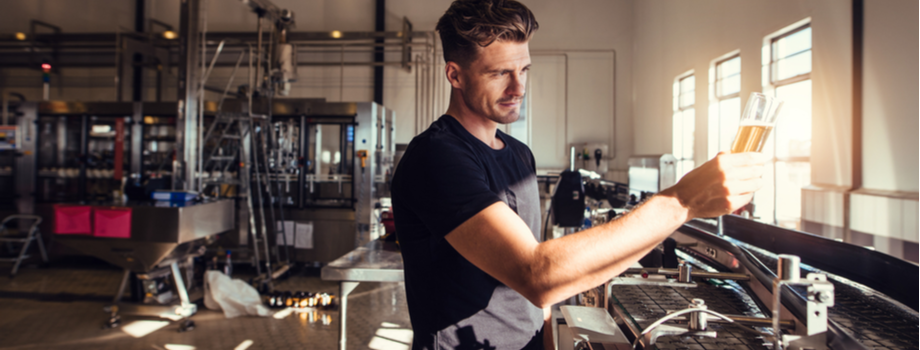Call Sales: +1 (833) 437-3835
Call Sales: +1 (833) 437-3835
Revel | January 19, 2018 |

Given that Americans spend three times as much on beer as they do on water, and in the U.S alone Americans spent $105.9 billion on beer in 2016, 2018's beer trends and predictions are more important than ever. Who knew combining barley, water, hops, and yeast would have such an economic impact!
With 2017 behind us, what are the beer trends and predictions for the beer industry in 2018?
The beer industry is a crowded market. And with reports of slowed growth, as well as nearly 8,000 active beer licenses as of March 2017, many are wondering if the beer industry has hit market saturation.
Bart Watson, Chief Economist of the Brewers’ Association eases fears of a bubble bursting saying, “Slower growth for many businesses is going to be very normal, it is not a bad thing, and is an indication of a maturing industry with room left for growth.” But competition is still stiff. And in response, large retail chains are diversifying their offerings while also decreasing the number of taps in-store.
Local brewers are hoptimistic
As it gets harder for brewers to get into retail, many local and small breweries are cutting out the middleman and selling directly from their premises. By selling directly, there is great opportunity for local and small brewers to connect to their community, build brand equity, and cut down on retailer costs. The desire for locally made beer continues to become more important to Millennial consumers, ensuring a steady market.
Mergers and acquisitions
Investment firms, private equity firms, and corporations like MillerCoors are buying a taste of craft. Notable acquisitions include MillerCoors majority stake in Oregon’s Hop Valley and Terrapin as well as the acquisition of Cigar City and Victory and Southern Tier by private equity firms.
This means craft beer is moving mainstream, now making up 12% of the beer market. While craft beer may be mainstream consumers place an importance on larger players to maintain the local identity of the acquired craft brew. Smaller players need to identify their unique value more clearly than ever and make community connections.
Who makes up that 12%? The trope of the hipster male drinking his craft beer has since been abandoned. For one, women are surging into a 2% share of the overall craft beer market, while women ages 21-34 compose a full 15% of overall craft drinking volume.
Additionally, there is a growing share of Hispanic craft beer drinking. Univision, IHS Global Insights finds that by 2019, Hispanic beer spending is projected to grow 31%.
Despite the increasing diversity in craft consumption – Millennials still make-up the most significant market share; 58% to be exact.
Milkshake IPAs
The popular IPA is getting a shake up. Brewers are now combining the key ingredient, lactose sugar, with fruits and oats to create a cloudier, fuller bodied, and sweeter IPA.
Barrel Aged Stouts
Brewers are applying the same methodology to stouts that winemakers have been doing for centuries, barrel-aging. It is most common to age dark and strong beers, like Stouts, in bourbon-soaked oak to deepen the flavor and increase the ABV.
Sours
Some may react to this trend with a pinched face, but sours are making their way into the mainstream. From fruit-infused sours to dry-hopped sours, tart and hoppy flavors should be on your drink menu.
Higher ABV
According to EeBria, around 11% of all craft beer sold in 2017 were 7% or higher. Thanks to craft beer pairings with food as well as the shifting culture towards greater beer appreciation – consumers want to drink beer like wine, and are asking for higher ABV beer.
Preminization of the can
Bottles are losing steam. While bottled craft beer is still the majority of packaging, cans are catching up in popularity. This is a result in the closing of the gap between perception of quality in cans versus bottles. Smaller craft brewers have been instrumental in driving this shift in perception by being the quickest to package their high-quality, craft made beers in cans.
Minimalism, layering, abstract & more
Apple’s popularization of minimalist branding has even trickled down to how designers design beer labels. More and more you will see negative space on the labels, and a crisp simplified look. Other branding trends include: layering and overlapping designs on the label, artistic and abstract designs, and brighter, bolder colors.
Explore these beer trends to stand out in a crowded landscape. To meet consumers’ ever changing demands and boost beer sales, it’s important you outfit your bar or brewery with the latest in iPad POS System technology. Tap into your potential by enhancing the customer experience through CRM and a tailored loyalty program and streamlining your back of house with intelligent reporting and ingredient-level inventory management.